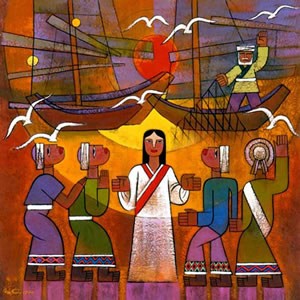by Admin
Share
Share

We gather for a Worship Service in-person at the Chapel (2700 W 14th Street) at 11:00 A.M. The Service is also available through the Zoom platform.
To join us at the Chapel, buzz Zion Church (Bob Bucklew) from the Directory at the front of the 2700 Building on the campus of San Sofia apartments or enter from the accessible ramp from the rear parking lot. When you arrive, call Bob at 216-375-5323 to open the parking lot gate.
The Sunday Bulletin is attached in PDF format. You may use it as a devotional during the week.
Following Worship, we invite you to enjoy coffee, refreshments, and warm conversation.
The Festival of Epiphany and the season that follows…
The Festival of Epiphany is not only marked by a single historical event but also by a series of events tied together by a theme. “Epiphany” means “revelation” or “new understanding,” and the biblical stories associated with Epiphany and the season that follows share a common “aha” quality.
The passages include the epiphany of the Magi who come to know the significance of the Messiah’s birth, the epiphany of Jesus who embraces his baptism and his life’s unique identity and mission, the epiphany of John the Baptizer who identifies Jesus as the Lamb of God, and the epiphany of the first disciples who leave behind the familiar to explore the radically new. These are all significant personal events of powerful discovery, self-realization, and transformation.
The United Church of Christ, along with the Evangelical Lutheran Church in America and the United Methodist Church, celebrates on the day of Epiphany, January 6th, (or the Sunday closest) the revelation of Christ to all nations as represented by the Magi who come to worship Jesus. The church calendar recognizes the season of Epiphany from January 6th until the last Sunday before Ash Wednesday which is celebrated as the Transfiguration of Christ/Transfiguration of our Lord. The length of the season of Epiphany varies and is determined by working backwards through the season of Lent from the moveable date for the celebration of Easter.
Among the principal themes are: the revelation of Christ to all nations, Jesus’ baptism in the River Jordan, and Christ as the light of the world. The colors of the season are white (a color associated with the festivals of Christ and suggesting gladness, joy and light for the day of Epiphany), used the first week after the Epiphany when the Baptism of Christ/Baptism of our Lord is celebrated, and the last week of the season of Epiphany when the Transfiguration of Christ/our Lord is celebrated; and green, reminiscent of living plants and suggests spiritual growth. Green is used in the season of Epiphany beginning with the second week after the Epiphany until the week before the Trans-figuration of Christ/Transfiguration of our Lord is celebrated.
These churches use the terms “Time after Epiphany” to describe this period. The expression with “after” has been interpreted as making the period in question correspond to that of Ordinary Time.**
**Ordinary Time refers to two periods of time in the Christian liturgical year that are found in the calendar of the ordinary form of the Roman Rite of the Catholic Church, as well as some other churches of Western Christianity, including the Anglican Communion, Methodist churches, Lutheran churches, Old Catholic churches and Reformed churches. In Latin, the name of this time is Tempus per annum translated as time during the year.
Ordinary Time comprises two periods: the first period begins on Epiphany Day (in the Anglican Communion and Methodist churches) or the day after the Feast of the Baptism of the Lord (in the Roman Catholic Church) and ends on the day before Ash Wednesday; the second period begins on the Monday after Pentecost, the conclusion of the Easter season, and continues until the Saturday before the First Sunday of Advent.
In some traditions, the first period is celebrated as the Season after Epiphany, and the latter of these periods is observed as the Season after Pentecost. Both of these periods of time, combined, are the longest time in the liturgical year. The weeks of Ordinary Time are numbered. Several Sundays bear the name of feasts or solemnities celebrated on those days, including Trinity Sunday and the Feast of Christ the King/Reign of Christ. The liturgical color normally assigned to Ordinary Time is green.**
Our Focus Scripture Reading this Sunday
Mark 1:15-20
Intro: The Gospel lesson of Mark 1 contains the beginning of Jesus’ ministry. After Jesus’ baptism and John the baptizer’s arrest, Jesus took up the same sermon message: “The reign of God is at hand! Change your hearts and minds (repent), and believe this Good News!” As Jesus ministered along the Sea of Galilee, he called his first disciples, those who fished by trade, to follow him and fish for people.
Two sets of brothers: Simon and Andrew, and James and John, were among the first. James and John even left their father Zebedee in the boat along with those Zebedee hired to help him with his fishing business, to follow Jesus.
The Sermon/Reflection is “The Time Is Now” by the Rev. Scott Rosenstein, based on the reading of Mark 1:15-20, and also referencing the readings from Jonah and 1 Corinthians.
Other Readings this Sunday – Introductions:
Jonah 3:1-5, 10 – We begin with the call of Jonah a second time to go to Nineveh, after he ran away the first time. Nineveh is notable in the Bible as the capital city of Assyria, a fearsome empire and a longtime enemy of Israel. Ninevah is located in what is now modern Iraq, In Jonah 3:1-5, the prophet obeys God and proclaims the message God sent him to deliver: in forty days, Nineveh, a large city, will be overthrown because they have not followed God’s ways. However, all the people of Nineveh, of all backgrounds, fasted and put on sackcloth, showing outwardly how they recognized where they had gone wrong and turned back to God. In verse 10, God recognized that they had changed from their evil ways, and God changed God’s mind about overthrowing the city. Jonah, in turn, was a very successful – but also very reluctant – prophet (and has some things to say about that in chapter 4).
Psalm 62:5-12 – These verses in Psalm 62 form is a contemplative psalm. The composer knows that God alone is their hope and salvation. The psalmist calls for all people to put their trust in God and not in wealth, for people of all economic standings come before God and wealth is not to be trusted. All power belongs to God, and God’s way is restoration: leveling out what is unequal and restoring what has been taken. The psalmist reminds us that God “repays” us according to the work we have done for God’s justice in this world.
1 Corinthians 7:29-31 – The Epistle readings in this season after Epiphany follow the letters to the Corinthians. In these verses in 1 Corinthians 7, the apostle Paul believed that the return of Christ was imminent. Paul saw the reign of heaven as one we ought to live into now: for in heaven, as Christ taught, there is no marriage, there are no possessions, and there is no more mourning. Paul believed the world we have known was passing and we ought to live in the reign of God here on earth.
Please join us this Epiphany season to give thanks to God in-person at Zion Chapel or via the Zoom platform.
Pastor Scott Rosenstein
216-273-7561 – church
216-577-1514 – mobile
Bulletin Cover Image:
Calling Disciples
by Chinese artist, He Qi, 1999
currently a California resident (USA),
Artist-in-Residence at Fuller Theological Seminary (CA)
from Art in the Christian Tradition
a project of the Vanderbilt Divinity Library, Nashville, TN.
https://diglib.library.vanderbilt.edu/act-imagelink.pl?RC= [retrieved January 17, 2024]

